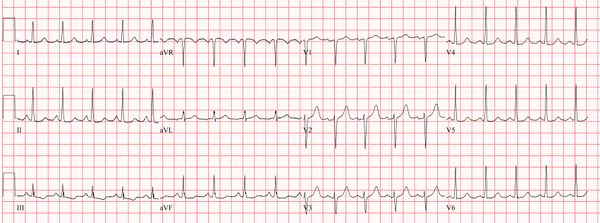Sinus Tachycardia
| This is part of: Supraventricular Rhythms |

Sinus tachycardia is sinus rhythm with a rate of > 100bpm. Sinus tachycardia is an example of a supraventricular rhythm. In sinus tachycardia the sinus node fires between 100 and 180 beats per minute, faster than normal. The maximal heart rate decreases with age from around 200 bpm to 140 bpm. Sinus tachycardia normally has a gradual start and ending. Most often sinus tachycardia is caused by an increase in the body's demand for oxygen, such as during exercise, stress, infection, blood loss and hyperthyroidism. It can also express an effort of the heart to compensate for a reduced stroke volume, as occurs during cardiomyopathy.
The maximal heart rate is considered to be 220/min minus the age (or more precisely 207-0.7xAge TanakaRobergs). However, this is often exceeded during vigorous exercise and has a large inter-individual variation.
Appropriate sinus tachycardia can result from: Surawicz
- Exercise
- Anxiety
- Alcohol / caffeine use
- Drugs (e.g. beta-agonists like dobutamine)
Inappropriate sinus tachycardia can result from:
- Fever
- Hypotension
- Hypoxia
- Congestive heart failure
- Bleeding
- Anemia
- Hyperthyroidism
- Cardiomyopathy (with reduced left ventricular function and compensatory tachycardia)
- Myocarditis
Inappropiate sinus tachycardia is rare and characterized by tachycardia at rest and exaggerated acceleration of the heart during physiologic stress. The mechanism leading to an exaggerated response of the sinus node to minimal physiologic stress is incompletely understood.
References
<biblio>
- Tanaka pmid=11153730
- Surawicz isbn=9780721686974
- Robergs Robergs and Landwehr. The Surprising History of the “HRmax=220-age” Equation. Journal of Exercise Physiology
online. 2 May 2002 </biblio>
